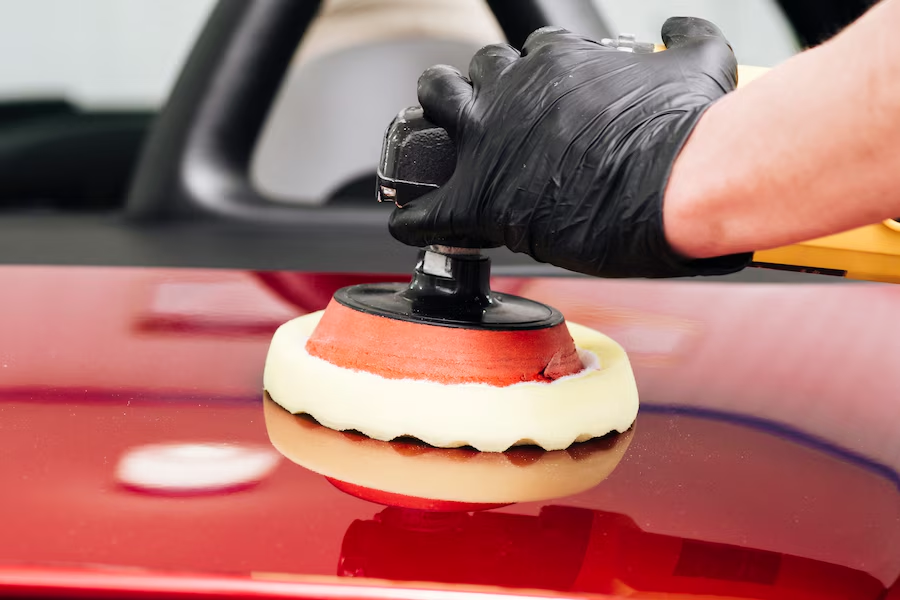Car polishing pads are integral to car detailing and apply compounds like polishes, waxes, or sealants to a vehicle’s surface. These pads help distribute the product evenly, allowing for a smooth, consistent application. Typically attached to a rotary or dual-action polisher, they play a crucial role in enhancing the shine and gloss of a vehicle’s paint, correcting surface defects, and protecting the car’s exterior. Pads come in various types, sizes, and materials, each designed for specific purposes such as cutting (removing heavy oxidation and scratches), polishing (refining the surface), or finishing (applying wax or sealants). Understanding the different types of pads and how they function is vital to achieving professional detailing results.
Types of Car Polishing Pads
Car polishing pads come in several varieties, each serving a specific role in detailing. Foam pads are the most common and versatile, available in different densities, determining their cutting or polishing abilities. Microfiber pads offer more cutting power for scratch removal while leaving a fine finish. Wool pads, on the other hand, are the most aggressive and are used for heavy cutting and oxidation removal. Choosing the correct pad type depends on the task: removing deep scratches, buffing out swirl marks, or applying finishing touches.
Choosing the Right Polishing Pads
Selecting the correct polishing pad is essential for achieving the desired result. The choice depends on the condition of the car’s paint, the used product, and the level of correction needed. A softer foam pad works well for light polishing or finishing, while a more aggressive wool or microfiber pad is preferable for cutting through deeper scratches or oxidation. Using the wrong pad can lead to suboptimal results or even paint damage, so matching the pad to the specific detailing task is critical.
Foam vs Microfiber
Polishing Pads Foam and microfiber pads are the two most common car polishing pads. Foam pads come in various densities and are ideal for multiple stages of the detailing process, from cutting to finishing. They provide a more even product application, making them versatile for professional and beginner detailers. Microfiber pads, conversely, are more effective at removing imperfections due to their higher cutting ability. These pads are generally more aggressive than foam but still leave a fine finish, making them ideal for removing heavy scratches or oxidation. Both types have their place in a detailer’s toolkit, but understanding their differences can help ensure the correct pad is used for the job.
Understanding Polishing Pad Colors
Many car polishing pads are colour-coded to indicate their level of abrasiveness. The colour system varies between manufacturers, but darker-coloured pads (like black or blue) are softer and used for finishing or applying waxes and sealants. Lighter-coloured pads (such as yellow or orange) are more aggressive and designed for cutting and heavy-duty polishing. This colour-coding helps detailers quickly identify the appropriate pad for each process step, from cutting to finishing, making it easier to achieve a high-quality finish without damaging the paint. Explore our premium collection of car care products at https://www.hzcarcare.co.uk/ – everything you need for a spotless, protected vehicle.
Polishing Pads for Cutting
Cutting pads are the most aggressive type of car polishing pads and are used for removing deep imperfections, scratches, and oxidation from a car’s paint. These pads, often made from wool or coarse foam, are designed to work with cutting compounds that strip away the damaged layers of paint, revealing a smooth, flawless surface beneath. While they can be highly effective at restoring heavily damaged paint, cutting pads should be used carefully to avoid over-removal of the clear coat or paint.
Polishing Pads for Finishing
Finishing pads are the softest type, designed to apply fine polish, wax, or sealant to a vehicle’s surface. These pads help bring out the final shine and gloss, leaving a smooth, mirror-like finish. Typically made from soft foam, finishing pads are used after the cutting and polishing stages to enhance the car’s appearance and protect the paint. They are not abrasive and are ideal for achieving that professional, high-gloss look.
Best Car Polishing Pads for Beginners
For beginners, foam pads are generally the best choice due to their versatility and ease of use. They offer a balanced performance for various tasks, from light cutting to finishing. Foam pads are forgiving, making them ideal for those new to car detailing who may still need to gain experience using more aggressive pads. With foam pads, beginners can achieve a good finish without worrying too much about damaging the paint, making them an excellent starting point for anyone learning how to polish cars.










